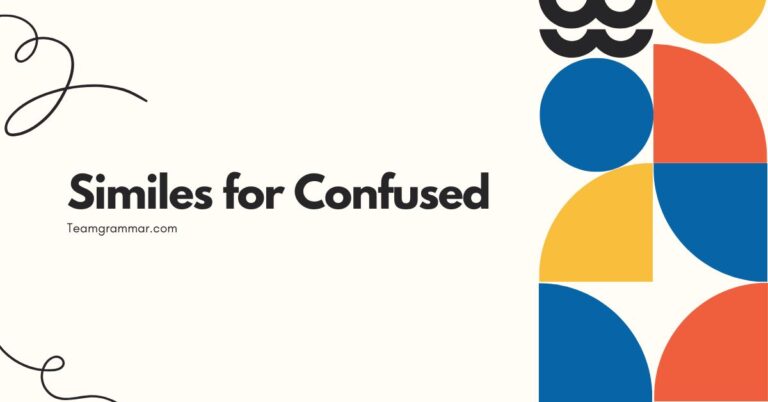39 Similes for Money: A Comprehensive Guide to Figurative Language
Understanding similes is crucial for mastering figurative language, adding depth and color to your writing and speech. Similes, by comparing one thing to another using “like” or “as,” provide vivid imagery and enhance comprehension.
This guide explores the nuances of similes related to money, offering a detailed explanation of their structure, types, and usage. It’s beneficial for English language learners, writers seeking to enrich their prose, and anyone interested in the art of effective communication.
Table of Contents
- Introduction
- Definition of Similes for Money
- Structural Breakdown of Similes
- Types of Similes for Money
- Examples of Similes for Money
- Usage Rules for Similes
- Common Mistakes with Similes
- Practice Exercises
- Advanced Topics in Similes
- FAQ Section
- Conclusion
Definition of Similes for Money
A simile is a figure of speech that compares two unlike things using the words “like” or “as.” The purpose of a simile is to create a vivid image or to emphasize a particular quality of the subject being described. When used in the context of money, similes can effectively illustrate the nature, value, or impact of financial resources or situations.
Similes are a subset of figurative language, which also includes metaphors, personification, and hyperbole. Unlike metaphors, which directly equate two things (e.g., “Time is money”), similes make a comparison using “like” or “as” (e.g., “Time is *like* money”).
This distinction is crucial for understanding and using similes correctly.
The function of similes in relation to money can vary widely. They might describe the abundance or scarcity of money, the speed at which it is earned or spent, or the emotional impact it has on individuals.
For instance, the phrase “Money burns a hole in his pocket like a wildfire” suggests that someone spends money quickly and perhaps recklessly. Understanding the nuances of such comparisons allows for more effective and evocative communication.
Structural Breakdown of Similes
The basic structure of a simile includes three key components: the subject, the linking word (“like” or “as”), and the comparative term. The subject is the thing being described, the linking word establishes the comparison, and the comparative term is the thing to which the subject is being compared.
For example, in the simile “Her wealth grew like a weed,” “her wealth” is the subject, “like” is the linking word, and “a weed” is the comparative term. This structure allows for a clear and understandable comparison, highlighting the rapid and uncontrolled growth of her wealth.
Variations in simile structure can involve adding adjectives or adverbs to provide more specific details. For example, “His investments plummeted as quickly as a stone falling into a well” adds the adverb “quickly” to emphasize the speed of the decline.
The adjective ‘deep’ could be added to ‘well’ to further enhance the depth of the financial loss. These additions enhance the imagery and convey a more nuanced meaning.
Understanding this basic structure is essential for both creating and interpreting similes effectively. By recognizing the subject, linking word, and comparative term, you can better understand the intended meaning and appreciate the artistry of the comparison.
Types of Similes for Money
Similes Describing Abundance
These similes illustrate large quantities of money or wealth. They often use comparisons to things that are perceived as plentiful or inexhaustible.
Example: “His bank account was as deep as the ocean.” This suggests a vast amount of money.
Similes Describing Scarcity
These similes highlight a lack of money or financial resources. They often use comparisons to things that are rare or difficult to obtain.
Example: “His savings were as thin as a wafer.” This indicates very little savings.
Similes Describing Speed of Expenditure
These similes focus on how quickly money is spent or lost. They often use comparisons to things that move or disappear rapidly.
Example: “The money vanished like smoke.” This suggests that the money was spent very quickly.
Similes Describing Value
These similes emphasize the worth or importance of money. They often use comparisons to things that are highly valued or essential.
Example: “Money is as good as gold in these times.” This highlights the importance and value of money during a particular period.
Similes Describing Financial Burden
These similes illustrate the weight or pressure associated with financial obligations. They often use comparisons to things that are heavy or restrictive.
Example: “The debt hung over him like a dark cloud.” This suggests a significant and oppressive financial burden.
Examples of Similes for Money
The following tables provide extensive examples of similes related to money, categorized by their descriptive focus. Each example is designed to illustrate how similes can be used to add depth and color to your writing and speech.
Table 1: Similes Describing Abundance
This table presents examples of similes that describe large quantities of money or wealth, using comparisons to things perceived as plentiful.
| Simile | Meaning |
|---|---|
| His wealth was as boundless as the sky. | He had an unlimited amount of money. |
| Her inheritance was like a river flowing endlessly. | She received a large and continuous stream of money. |
| Their savings were as deep as a well. | They had a substantial amount of money saved. |
| His fortune grew like mushrooms after rain. | His wealth increased rapidly and abundantly. |
| The company’s profits were as plentiful as grains of sand. | The company made a lot of money. |
| His riches spread as wide as an ocean. | He possessed extensive wealth. |
| Her assets accumulated like snowflakes in a blizzard. | Her assets grew quickly and abundantly. |
| His income flowed as freely as a waterfall. | He had a consistent and abundant income. |
| Her earnings piled up like leaves in autumn. | Her earnings accumulated quickly and substantially. |
| His investments blossomed like flowers in spring. | His investments yielded significant returns. |
| His wealth glittered like stars in the night sky. | His wealth was dazzling and impressive. |
| Her bank account was as full as a treasure chest. | She had a significant amount of money in her account. |
| Their financial resources were like an endless supply. | They had access to a limitless amount of money. |
| His profits rolled in like waves on the shore. | He consistently earned a substantial amount of money. |
| The company’s revenue soared as high as a mountain. | The company’s revenue reached an impressive level. |
| His coffers overflowed like a river in flood. | He had an excessive amount of money. |
| Her wealth expanded like a universe. | Her wealth grew immensely. |
| His financial empire stood as tall as a skyscraper. | He had a vast and impressive financial empire. |
| Her riches mounted like mountains. | Her riches accumulated to a great extent. |
| His earnings accumulated like interest in a savings account. | His earnings steadily increased over time. |
| His abundance was as vast as space. | He had an immeasurable amount of wealth. |
| Her monetary gains were like a never-ending fountain. | She consistently gained money without stopping. |
| Their wealth was as expansive as the land. | They had a considerable amount of wealth. |
| His profits grew like branches on a tree. | His profits increased steadily and significantly. |
| The company’s funds were as boundless as the sea. | The company had an unlimited amount of funds. |
Table 2: Similes Describing Scarcity
This table offers examples of similes that highlight a lack of money or financial resources, using comparisons to things that are rare or difficult to obtain.
| Simile | Meaning |
|---|---|
| His wallet was as empty as a ghost town. | He had no money in his wallet. |
| Her savings were like a drop in the ocean. | She had very little savings. |
| His bank account was as dry as the desert. | He had no money in his bank account. |
| Their financial situation was as bleak as a winter landscape. | They were in a very difficult financial situation. |
| His resources were as limited as a prisoner’s rations. | He had very few resources available. |
| Her budget was as tight as a drum. | She had very little money to spend. |
| His funds were as scarce as hen’s teeth. | He had very little money available. |
| Their income was as meager as a trickle. | They had a very small income. |
| His financial prospects were as dim as a dying ember. | His financial future looked bleak. |
| Her wealth was as invisible as the wind. | She had no visible wealth. |
| His account balance was as barren as a wasteland. | He had virtually no money in his account. |
| Her financial security was as fragile as glass. | She was in a very precarious financial situation. |
| Their money disappeared like dew in the morning sun. | They quickly lost all their money. |
| Her financial cushion was as thin as paper. | She had very little money to fall back on. |
| His economic state was as vulnerable as a newborn. | He was in a very weak financial position. |
| Her disposable income was as rare as a blue moon. | She rarely had extra money to spend. |
| His financial stability was as shaky as a house of cards. | He was in an unstable financial situation. |
| Her savings were as minimal as a sparrow’s meal. | She had very little savings. |
| His access to capital was as restricted as a desert spring. | He had very limited access to money. |
| Her financial outlook was as grim as a cloudy day. | Her financial future looked unpromising. |
| His reserve funds were like whispers in the wind. | He had almost no reserve funds. |
| Her liquid assets were as elusive as a mirage. | She struggled to access her assets easily. |
| Their financial health was as delicate as a butterfly. | They were in a precarious financial state. |
| His available cash was as limited as an oasis in the desert. | He had very little cash available. |
| Her economic strength was as feeble as a flickering candle. | She had very little economic strength. |
Table 3: Similes Describing Speed of Expenditure
This table provides examples of similes that focus on how quickly money is spent or lost, using comparisons to things that move or disappear rapidly.
| Simile | Meaning |
|---|---|
| The money went as fast as lightning. | The money was spent very quickly. |
| His savings disappeared like snow in summer. | His savings vanished quickly. |
| Her cash flowed out like water. | She spent money very easily and quickly. |
| The funds evaporated like mist in the sun. | The funds disappeared rapidly. |
| His money burned a hole in his pocket like wildfire. | He spent money quickly and impulsively. |
| Her earnings vanished like a puff of smoke. | She quickly spent all her earnings. |
| The cash was gone as quickly as a shooting star. | The money disappeared almost instantly. |
| His fortune dwindled like sand through an hourglass. | His fortune decreased steadily and rapidly. |
| Her money slipped through her fingers like water. | She was unable to hold onto her money. |
| The investments plummeted as fast as a falling rock. | The investments quickly lost value. |
| Her funds drained away like a leaking faucet. | Her money was steadily being spent. |
| His savings were depleted as quickly as ice melting. | His savings were used up very fast. |
| Their money flew away like birds in the wind. | They rapidly lost their money. |
| Her budget was consumed as fast as a forest fire. | Her allocated money was used up very quickly. |
| His assets evaporated like a dream. | His assets quickly disappeared. |
| Their cash reserves were depleted as readily as fuel in a race car. | They rapidly used up all their cash reserves. |
| Her wealth disappeared faster than shadows at noon. | She lost her wealth incredibly quickly. |
| His funds were spent as eagerly as candy on Halloween. | He spent his funds very quickly and enthusiastically. |
| Her money was squandered like seeds thrown to the wind. | She wasted her money carelessly. |
| His finances were exhausted as quickly as air from a punctured tire. | His finances were rapidly used up. |
| Her capital was used up as swiftly as a candle burning at both ends. | She quickly depleted her capital. |
| His money vanished like a footprint in the sand. | His money disappeared completely without a trace. |
| Their investments diminished as sharply as a cliff’s edge. | Their investments declined steeply and suddenly. |
| Her finances declined as rapidly as autumn leaves falling. | Her finances deteriorated very fast. |
| His available funds were exhausted as swiftly as a race against time. | He quickly used up all his available funds. |
Table 4: Similes Describing Value
This table includes similes that emphasize the worth or importance of money, using comparisons to things that are highly valued or essential.
| Simile | Meaning |
|---|---|
| Money is as precious as water in the desert. | Money is essential for survival. |
| His savings were like gold dust to him. | He highly valued his savings. |
| Her investments were as valuable as rare gems. | Her investments were very precious. |
| Money is as vital as the air we breathe. | Money is essential for life. |
| His financial security was like a fortress. | He felt protected and secure because of his money. |
| Her income was as reliable as the sunrise. | She could always count on her income. |
| Money is as useful as a Swiss Army knife. | Money can be used for many different purposes. |
| His financial advice was as priceless as wisdom. | His financial advice was extremely valuable. |
| Her wealth was as comforting as a warm blanket. | She felt secure and comfortable because of her wealth. |
| Money is as necessary as sunlight to plants. | Money is essential for growth and prosperity. |
| His financial planning was as astute as a chess master. | His financial planning was very strategic and skillful. |
| Her assets were as carefully guarded as crown jewels. | She protected her assets with great care. |
| Money is as crucial as a compass to a sailor. | Money is essential for navigating life’s challenges. |
| His savings were as secure as a vault. | His savings were well-protected and safe. |
| Her financial independence was as liberating as freedom. | She felt free and empowered because of her financial independence. |
| Money is as enabling as a key to a locked door. | Money provides opportunities and access. |
| His investments were as beneficial as a life-saving medicine. | His investments provided significant benefits. |
| Her financial knowledge was as powerful as a magic spell. | Her financial knowledge gave her great influence. |
| Money is as fundamental as the roots of a tree. | Money provides a solid foundation. |
| His financial decisions were as sound as a well-built bridge. | His financial decisions were reliable and effective. |
| Money is as essential as fuel for a car. | Money is necessary to keep things running smoothly. |
| His financial acumen was as sharp as a surgeon’s scalpel. | He had a very keen understanding of financial matters. |
| Her wealth was as sustaining as fertile soil. | Her wealth provided long-term support. |
| Money is as indispensable as tools for a craftsman. | Money is essential for achieving goals. |
| His financial strategy was as precise as a mathematical equation. | His financial strategy was carefully calculated and accurate. |
Table 5: Similes Describing Financial Burden
This table provides similes that illustrate the weight or pressure associated with financial obligations, using comparisons to things that are heavy or restrictive.
| Simile | Meaning |
|---|---|
| The debt weighed on him like a ton of bricks. | He felt burdened by his debt. |
| His financial worries were like a heavy anchor. | He was weighed down by his financial concerns. |
| Her expenses were as crushing as a landslide. | She was overwhelmed by her expenses. |
| The loan hung over them like a dark cloud. | They were constantly worried about the loan. |
| His financial obligations were as binding as chains. | He felt restricted by his financial responsibilities. |
| Her debt was like a ball and chain. | She felt trapped by her debt. |
| His financial stress was as suffocating as a tight collar. | He felt overwhelmed by financial stress. |
| Her bills piled up like mountains. | She had a large number of unpaid bills. |
| The financial burden was like a heavy cloak. | They were weighed down by their financial burden. |
| His financial troubles were as relentless as a storm. | He faced constant financial challenges. |
| The taxes felt like a constant drain. | The taxes constantly reduced their financial resources. |
| His financial worries haunted him like ghosts. | He was constantly troubled by his financial concerns. |
| Her student loans were as oppressive as a dictatorship. | She felt burdened and controlled by her student loans. |
| His mortgage felt like a life sentence. | He felt committed to paying off his mortgage for a long time. |
| The financial pressures were as intense as a burning fire. | They faced extreme financial pressures. |
| His financial commitments were as restricting as handcuffs. | He felt limited by his financial commitments. |
| Her financial constraints were as limiting as prison walls. | She felt confined by her financial limitations. |
| His debt was as burdensome as carrying a boulder uphill. | He struggled to manage his debt. |
| The financial responsibilities were as demanding as raising a child. | They required constant attention and effort. |
| His financial problems were as persistent as a nagging cough. | He faced ongoing financial issues. |
| The economic hardship felt like trudging through mud. | They struggled through difficult financial times. |
| His financial obligations were as relentless as the tides. | He had constant and unavoidable financial responsibilities. |
| Her financial woes were as harrowing as navigating a minefield. | She faced dangerous and stressful financial challenges. |
| His financial crisis was as overwhelming as being caught in a flood. | He felt completely consumed by his financial crisis. |
| The financial strain felt like being squeezed in a vise. | They experienced intense financial pressure. |
Usage Rules for Similes
Using similes effectively involves adhering to certain rules to ensure clarity and impact. The most important rule is that the two things being compared must be genuinely unlike each other.
A simile should draw attention to a shared quality or characteristic in a creative and insightful way.
Another key rule is to avoid clichés. Overused similes such as “as busy as a bee” or “as strong as an ox” have lost their impact and can make your writing seem unoriginal.
Strive to create fresh and imaginative comparisons.
Consistency in tone is also important. The simile should match the overall tone of your writing.
A humorous simile would be out of place in a serious or somber context, and vice versa. Consider the audience and the purpose of your writing when choosing your similes.
Finally, ensure that the comparison is clear and understandable. The reader should be able to easily grasp the connection between the two things being compared.
If the comparison is too obscure or convoluted, it will fail to achieve its intended effect.
Common Mistakes with Similes
One common mistake is confusing similes with metaphors. Remember that similes use “like” or “as” to make a comparison, while metaphors directly equate two things.
For example:
- Incorrect (Metaphor): Money is a bottomless pit.
- Correct (Simile): Money is *like* a bottomless pit.
Another frequent error is using illogical comparisons. The two things being compared should share a relevant characteristic.
For example:
- Incorrect: His money was as red as a car.
- Correct: His money was as tight as a drum.
Using clichés, as mentioned earlier, is also a common mistake. While clichés might be easily understood, they lack originality and impact.
Strive for fresh and creative comparisons.
Finally, ensure that your similes are grammatically correct. The comparison should be clear and unambiguous.
For example:
- Incorrect: She spends money like is going out of style.
- Correct: She spends money like *it* is going out of style.
Practice Exercises
Exercise 1: Identifying Similes
Identify the similes in the following sentences.
| Question | Answer |
|---|---|
| 1. His debt was as heavy as a mountain. | as heavy as a mountain |
| 2. Money is the root of all evil. | No simile present (Metaphor) |
| 3. Her savings vanished like smoke. | vanished like smoke |
| 4. Their financial situation was bleak. | No simile present |
| 5. The company’s profits grew like weeds in a garden. | grew like weeds in a garden |
| 6. The budget was as tight as a drum. | as tight as a drum |
| 7. Money talks. | No simile present (Personification) |
| 8. His wealth was as boundless as the sky. | as boundless as the sky |
| 9. The loan hung over them like a dark cloud. | like a dark cloud |
| 10. The cash flowed out like water. | flowed out like water |
Exercise 2: Completing Similes
Complete the following similes using appropriate comparisons.
| Question | Answer |
|---|---|
| 1. His wallet was as empty as _____. | a ghost town |
| 2. Her savings were like _____ in the ocean. | a drop |
| 3. The money went as fast as _____. | lightning |
| 4. Money is as precious as _____ in the desert. | water |
| 5. The debt weighed on him like _____. | a ton of bricks |
| 6. The company’s profits were as plentiful as _____. | grains of sand |
| 7. The funds evaporated like _____ in the sun. | mist |
| 8. Her income was as reliable as _____. | the sunrise |
| 9. His money burned a hole in his pocket like _____. | wildfire |
| 10. Their budget was consumed as fast as _____. | a forest fire |
Exercise 3: Creating Similes
Create your own similes to describe the following financial situations.
| Question | Example Answer |
|---|---|
| 1. Someone who is very wealthy. | His wealth was as vast as an empire. |
| 2. Someone who is deeply in debt. | Her debt was like a bottomless pit. |
| 3. A sudden financial windfall. | The unexpected bonus was like winning the lottery. |
| 4. The stress of managing finances. | Managing finances felt like juggling knives. |
| 5. A poor investment. | The investment was as useless as a screen door on a submarine. |
| 6. A stable and secure financial situation. | His financial security was as sturdy as a fortress. |
| 7. Rapid and reckless spending. | He spent money like there was no tomorrow. |
| 8. A long-term financial plan. | Her financial plan was as detailed as a blueprint. |
| 9. The impact of a recession. | The recession hit the economy like a tsunami. |
| 10. The importance of saving money. | Saving money is as crucial as preparing for a journey. |
Advanced Topics in Similes
For advanced learners, exploring more complex aspects of similes can enhance their understanding and usage. This includes analyzing similes in literature, studying the cultural context of similes, and experimenting with unconventional comparisons.
Analyzing similes in literature involves examining how authors use similes to create specific effects, such as evoking emotions, providing insights into characters, or enhancing the overall theme of the work. By studying examples from various literary genres, you can gain a deeper appreciation for the artistry of simile usage.
The cultural context of similes is also important to consider. Similes often draw on cultural references and shared experiences, so understanding the cultural background of a simile can help you interpret its meaning more accurately.
For example, a simile that references a specific historical event or cultural tradition might not be immediately clear to someone unfamiliar with that context.
Experimenting with unconventional comparisons can lead to the creation of unique and memorable similes. This involves thinking outside the box and exploring unexpected connections between seemingly unrelated things.
The key is to find a shared quality or characteristic that makes the comparison insightful and meaningful.
FAQ Section
- What is the difference between a simile and a metaphor?
A simile compares two things using “like” or “as,” while a metaphor directly equates them without using these words. For example, “Time is like money” (simile) versus “Time is money” (metaphor).
- Why are similes important in writing?
Similes add vividness, clarity, and depth to writing. They help readers visualize and understand concepts by drawing comparisons to familiar things, making the writing more engaging and memorable.
- How can I avoid using clichés in my similes?
To avoid clichés, try to think beyond the obvious comparisons. Brainstorm unique and unexpected connections between the subject and the comparative term. The more specific and original your simile, the more impactful it will be.
- Can a simile be too complex?
Yes, a simile can be too complex if the comparison is too obscure or convoluted. The reader should be able to easily understand the connection between the two things being compared. If the simile requires too much interpretation, it will lose its effectiveness.
- What are some common themes for similes about money?
Common themes include the abundance or scarcity of money, the speed at which it is earned or spent, the value or importance of money, and the emotional impact it has on individuals.
- How do similes enhance descriptive writing?
Similes enhance descriptive writing by providing concrete and relatable comparisons. They allow writers to paint a vivid picture in the reader’s mind, making the description more engaging and memorable. For example, describing debt as “weighing like a ton of bricks” creates a powerful image of burden.
- Is it possible to overuse similes?
Yes, it is possible to overuse similes. Using too many similes in a short passage can make the writing feel cluttered and distracting. Use similes judiciously, only when they add significant value to the writing.
- How do cultural contexts affect the interpretation of similes?
Cultural contexts can significantly affect the interpretation of similes because similes often draw on shared cultural references and experiences. A simile that is clear and meaningful to one cultural group might be confusing or nonsensical to another.
- What are some good resources for improving my simile writing skills?
Reading widely is a great way to improve your simile writing skills. Pay attention to how authors use similes in their writing and try to identify the specific effects they are trying to achieve. You can also practice creating your own similes on a regular basis, experimenting with different comparisons and themes.
- How can similes be used in business communication?
Similes can be used in business communication to make complex concepts more understandable and relatable. For example, describing a company’s growth as “expanding like a universe” can convey a sense of rapid and significant progress
.”
Conclusion
Similes are a powerful tool for enhancing communication, adding depth and color to writing and speech. By understanding the structure, types, and usage rules of similes, you can effectively use them to create vivid images and convey complex ideas.
Whether you are describing the abundance of wealth, the scarcity of resources, or the emotional impact of financial situations, similes can help you communicate more effectively and engagingly.
Remember to avoid common mistakes such as confusing similes with metaphors, using illogical comparisons, and relying on clichés. Strive for originality and clarity in your similes, and always consider the context and audience of your writing.
With practice and attention to detail, you can master the art of using similes to enrich your communication and captivate your readers.







